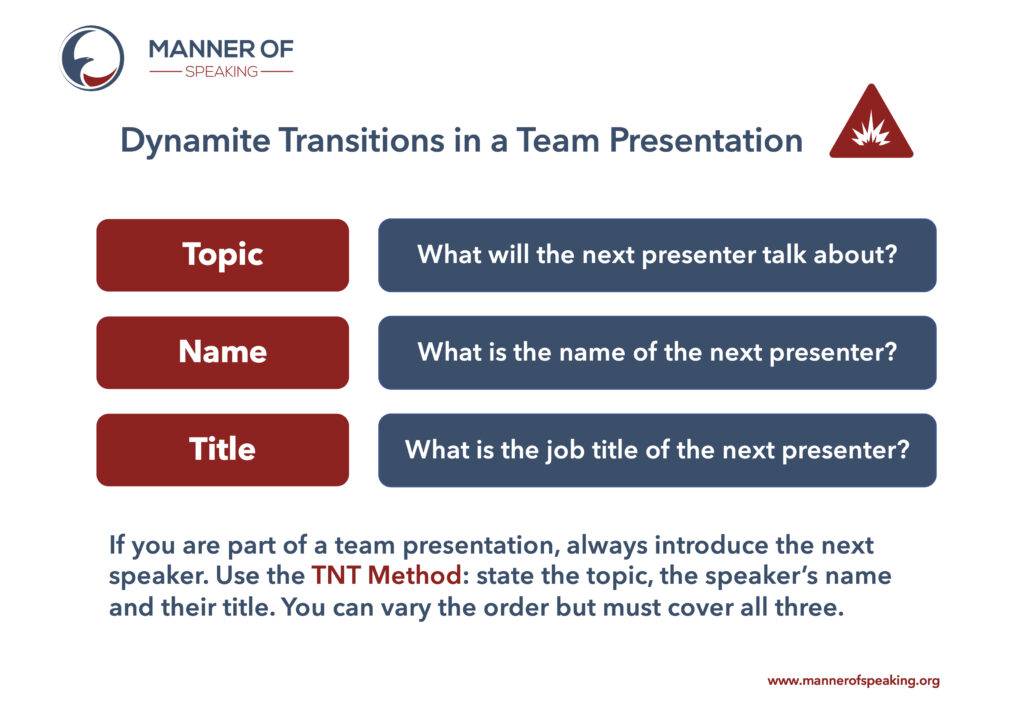Team presentations are dynamic. Having different speakers is a great way to showcase the skills and expertise of multiple individuals within an organization. However, to ensure that your team presentation is effective and engaging, it is essential that you pay attention to the transitions between presenters. Too often, they are often overlooked.
The seams of your presentation
Transitions are like the seams in a shirt or blouse, i.e., the join where two pieces of fabric are held together by stitching. They make up a small part of the whole and when they work well, you don’t even notice them. But if the seams are disjointed, it is a problem and it shows. The same applies to team presentations.
Smooth and seamless transitions in a team presentation demonstrate good teamwork, help keep the audience engaged, and ensure that the flow of the presentation is clear and easy to follow. Disjointed transitions have the opposite effect.
The audience wants to see one team, not a bunch of individuals.
Make your team presentation dynamite
Every presenter in a team presentation has an obligation to introduce the next team member who will speak. It is the logical (and polite) thing to do. Transitions from one team member to another do not have to be complicated. To the contrary, they should be crisp and short. To make them effective, remember the acronym for dynamite and use what I call the TNT Method.
The current presenter should briefly summarize the topic of the next presentation, introduce the next presenter by name, and provide their job title (Topic-Name-Title). This helps to give the audience a clear idea of what to expect and also serves as a cue for the next presenter to begin his or her part of presentation.
For example, imagine that the current presenter has just finished speaking about a new product that the company has just developed. In the next part of the presentation, the team will discuss how to market the product in Asia. The current presenter might say something like, “We see great potential for this product in Asia. To explain our marketing strategy [Topic], I hand over to Jessica Adams [Name], our Director of Marketing [Title].”
Such a transition would take less than 10 seconds. Nonetheless, it would give the audience a clear idea of what to expect and would introduce the next presenter in a simple, professional manner.
You can change the order
I call this the TNT Method as a way of making it easy to remember. However, you can order the three elements—Topic / Name / Title—differently. The key is to mention them all. Let’s look at some alternatives:
- To explain our marketing strategy [Topic], I hand over to Jessica Adams [Name], our Director of Marketing [Title].
- To explain our marketing strategy [Topic], I hand over to our Director of Marketing [Title], Jessica Adams [Name].
- I now hand over to Jessica Adams [Name], our Director of Marketing [Title], to explain our marketing strategy [Topic].
- I now hand over to our Director of Marketing [Title], Jessica Adams [Name], to explain our marketing strategy [Topic].

Transitions between presenters should be well timed. You should neither rush nor drag out the transitions, as this can disrupt the flow of the presentation and make it difficult for the audience to follow along. Instead, speak slowly and keep the transitions short and to the point, while still providing all the necessary information.
Good transitions are key to a successful team presentation. By using the TNT Method, paying attention to the flow and structure of the presentation, and timing the transitions well, you can help ensure that your team presentation is engaging, effective, and easy to follow. When they are done well, team presentations are dynamite!
For more on transitions in a speech in a speech or presentation, including eight kinds of transitions with 33 examples, please see this post.
















